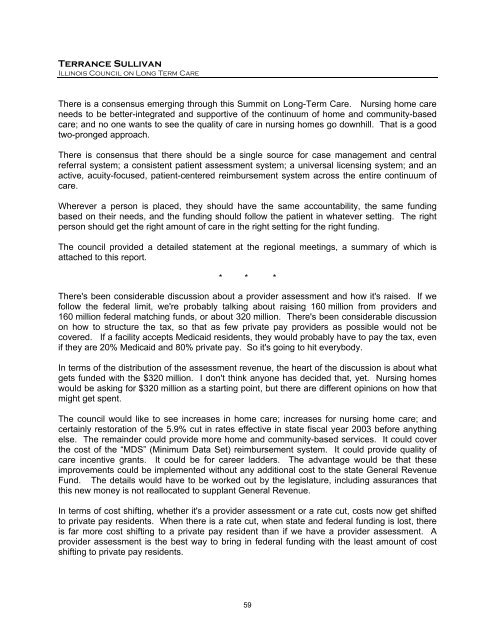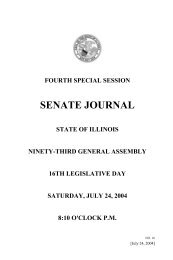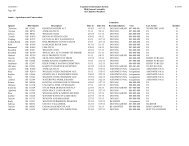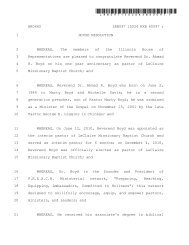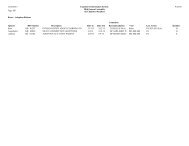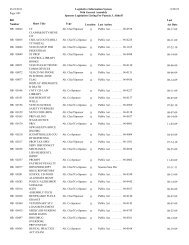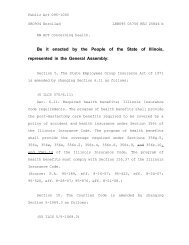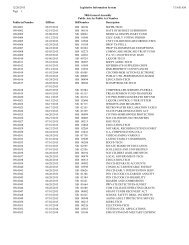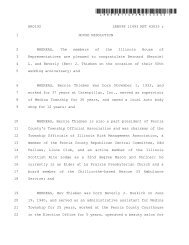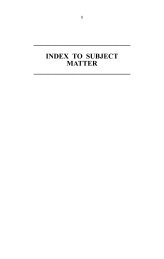Long-Term Care - Illinois General Assembly
Long-Term Care - Illinois General Assembly
Long-Term Care - Illinois General Assembly
You also want an ePaper? Increase the reach of your titles
YUMPU automatically turns print PDFs into web optimized ePapers that Google loves.
Terrance Sullivan<br />
<strong>Illinois</strong> Council on <strong>Long</strong> <strong>Term</strong> <strong>Care</strong><br />
There is a consensus emerging through this Summit on <strong>Long</strong>-<strong>Term</strong> <strong>Care</strong>. Nursing home care<br />
needs to be better-integrated and supportive of the continuum of home and community-based<br />
care; and no one wants to see the quality of care in nursing homes go downhill. That is a good<br />
two-pronged approach.<br />
There is consensus that there should be a single source for case management and central<br />
referral system; a consistent patient assessment system; a universal licensing system; and an<br />
active, acuity-focused, patient-centered reimbursement system across the entire continuum of<br />
care.<br />
Wherever a person is placed, they should have the same accountability, the same funding<br />
based on their needs, and the funding should follow the patient in whatever setting. The right<br />
person should get the right amount of care in the right setting for the right funding.<br />
The council provided a detailed statement at the regional meetings, a summary of which is<br />
attached to this report.<br />
* * *<br />
There's been considerable discussion about a provider assessment and how it's raised. If we<br />
follow the federal limit, we're probably talking about raising 160 million from providers and<br />
160 million federal matching funds, or about 320 million. There's been considerable discussion<br />
on how to structure the tax, so that as few private pay providers as possible would not be<br />
covered. If a facility accepts Medicaid residents, they would probably have to pay the tax, even<br />
if they are 20% Medicaid and 80% private pay. So it's going to hit everybody.<br />
In terms of the distribution of the assessment revenue, the heart of the discussion is about what<br />
gets funded with the $320 million. I don't think anyone has decided that, yet. Nursing homes<br />
would be asking for $320 million as a starting point, but there are different opinions on how that<br />
might get spent.<br />
The council would like to see increases in home care; increases for nursing home care; and<br />
certainly restoration of the 5.9% cut in rates effective in state fiscal year 2003 before anything<br />
else. The remainder could provide more home and community-based services. It could cover<br />
the cost of the “MDS” (Minimum Data Set) reimbursement system. It could provide quality of<br />
care incentive grants. It could be for career ladders. The advantage would be that these<br />
improvements could be implemented without any additional cost to the state <strong>General</strong> Revenue<br />
Fund. The details would have to be worked out by the legislature, including assurances that<br />
this new money is not reallocated to supplant <strong>General</strong> Revenue.<br />
In terms of cost shifting, whether it's a provider assessment or a rate cut, costs now get shifted<br />
to private pay residents. When there is a rate cut, when state and federal funding is lost, there<br />
is far more cost shifting to a private pay resident than if we have a provider assessment. A<br />
provider assessment is the best way to bring in federal funding with the least amount of cost<br />
shifting to private pay residents.<br />
59


